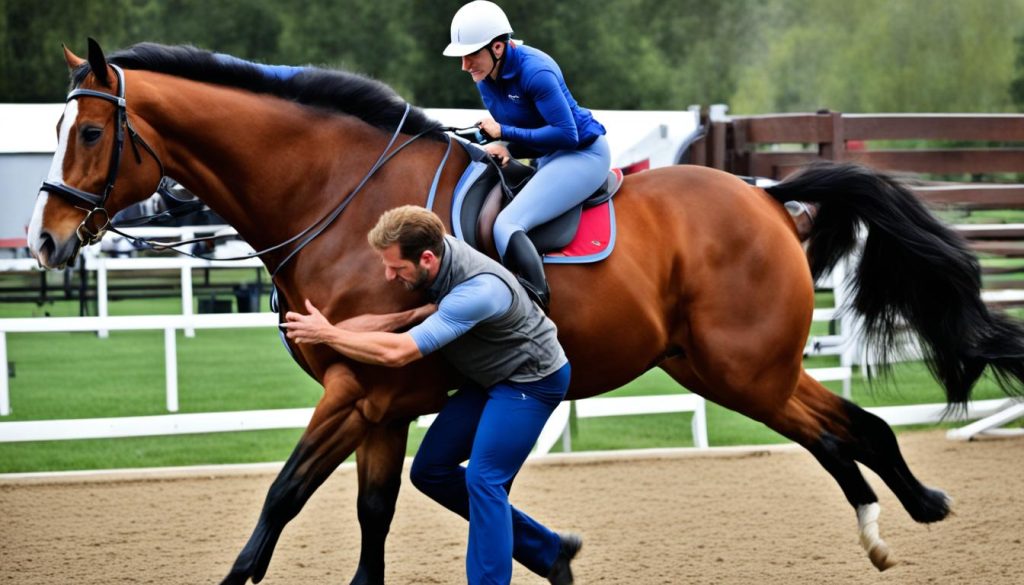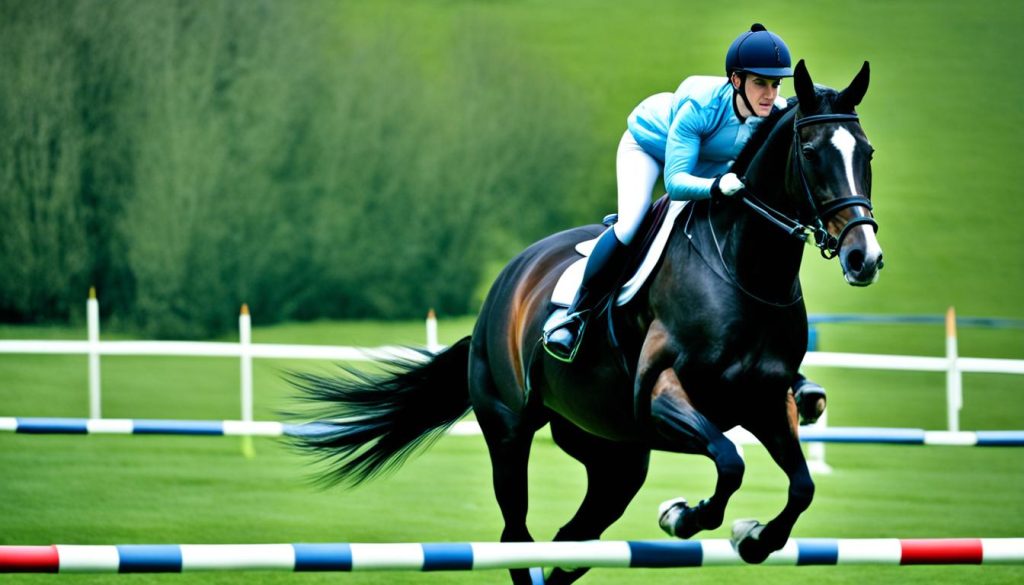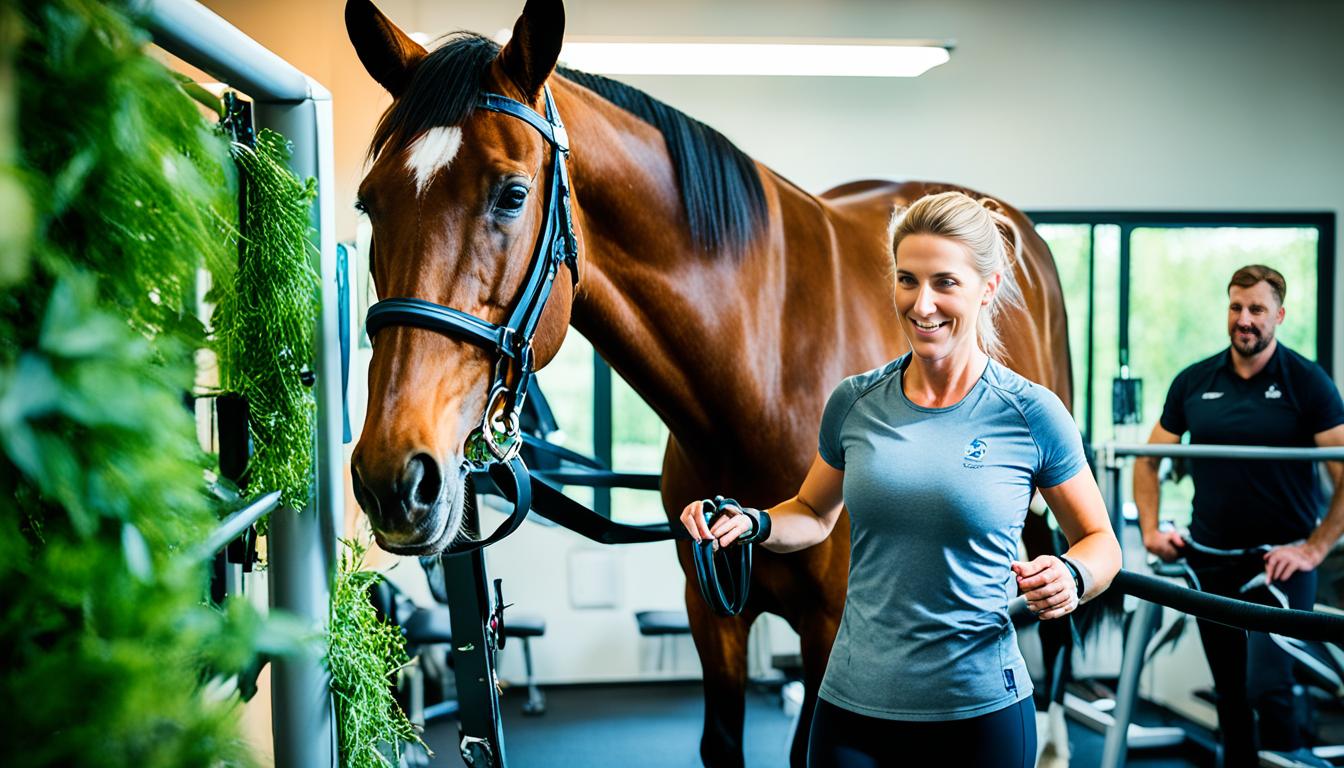Did you know that equine rehabilitation and recovery training play a crucial role in ensuring the well-being and optimal performance of horses? From rehabilitating injuries to enhancing overall fitness, these training techniques are essential for maintaining the health and longevity of our equine companions.
In this article, we will explore the importance of targeted muscle training, effective exercises for horse training, rehabilitation techniques, creating an optimal rehabilitation environment, and the benefits of cryotherapy and heat therapy in equine rehabilitation. By understanding and implementing these strategies, you can assist your horse’s recovery and help them reach their full potential.
Key Takeaways:
- Rehabilitation and recovery training are vital for horse wellness and performance.
- Targeted muscle training improves balance, coordination, and stability in horses.
- Exercises such as nose wiggling, spinal mobilization, and ground poles strengthen muscles and improve flexibility.
- Various techniques like massage therapy, stretching exercises, and chiropractic methods aid in horse rehabilitation.
- An optimal rehabilitation environment includes good ventilation, natural light, and safe footing.
The Importance of Targeted Muscle Training in Equine Development
Training horses involves more than just enhancing physical appearance or gait. It is important to develop a strong partnership by focusing on targeted muscle training, particularly the often-overlooked postural muscles. These muscles play a crucial role in maintaining balance, coordination, and stability in horses.
By engaging in exercises that target intrinsic muscles surrounding the spine and joints, you can not only strengthen your horse physically but also refine its ability to move with precision and control. Through equine exercise, your horse can develop muscle memory and improve its overall equine well-being.
“Precision and control are vital components of successful equine training. By targeting the postural muscles and intrinsic muscles, you can ensure your horse’s optimum performance.”
Regular exercises that focus on the intrinsic and postural muscles promote the development of precision and control, allowing your horse to move more efficiently and effortlessly. These exercises can include activities such as lateral movements, pole work, and exercises that encourage collection and engagement.
Focusing on Intrinsic Muscles for Precision and Control
When considering equine development, it is essential to pay attention to the intrinsic muscles as they contribute significantly to a horse’s overall strength and stability. These muscles are located deep within the body, surrounding the spine and joints, and are responsible for postural support and flexibility.
By engaging in exercises that target the intrinsic muscles, you can improve your horse’s core strength, balance, and coordination. These exercises may include lateral work, circles, serpentines, and transitions between gaits.
Developing precision and control through targeted muscle training not only enhances your horse’s physical capabilities but also improves its overall well-being. By incorporating these exercises into your training routine, you can ensure that your horse stays fit, healthy, and performs at its best.

Exercises for Effective Horse Training
When it comes to training and rehabilitating horses, incorporating a variety of exercises is essential for their overall development and well-being. These exercises target different aspects of equine fitness, including warm-up exercises, equine proprioception, muscle strengthening, joint range of motion, and core strength. By regularly integrating these exercises into your horse’s training routine, you can enhance their performance and promote optimal health.
Warm-up Exercises
Warm-up exercises are crucial to prepare your horse’s body for the physical demands of training. They help increase blood flow, loosen muscles, and enhance joint mobility. Some effective warm-up exercises include:
- Circle exercises to engage the hindquarters.
- Walking over ground poles to encourage coordination and balance.
- Stretching exercises to improve flexibility.
These warm-up exercises set the foundation for a productive training session and reduce the risk of injuries.
Equine Proprioception and Muscle Strengthening
Equine proprioception refers to a horse’s sense of its body position and movement in space. By incorporating exercises that challenge proprioception, you can improve your horse’s balance and coordination. Some exercises that target equine proprioception and muscle strengthening include:
- Nose wiggling exercises to release tension and engage the neck muscles.
- Spinal mobilization exercises to improve flexibility and core strength.
- Sensory re-education paths to enhance proprioception and spatial awareness.
These exercises not only enhance your horse’s physical fitness but also promote mental engagement and body awareness.
Maintaining Joint Range of Motion and Core Strength
It’s important to prioritize exercises that maintain joint range of motion and core strength in your horse’s training regimen. These exercises help prevent stiffness, promote flexibility, and support overall musculoskeletal health. Some exercises to consider include:
- Ditch crossing exercises to engage the hind end and improve joint mobility.
- Sideways movements to challenge lateral flexibility and core strength.
- Routine ground pole exercises to promote coordination, balance, and joint flexion.
These exercises target specific muscle groups and joints, ensuring your horse maintains optimal physical function throughout its training program.
Implementing these various exercises into your horse’s training routine will not only promote physical fitness but also contribute to their overall well-being and longevity. It’s important to consult with a qualified equine professional to design a training plan that suits your horse’s needs and abilities.

| Exercise | Objective |
|---|---|
| Circle Exercises | Engage hindquarters, improve flexibility |
| Walking Over Ground Poles | Enhance coordination and balance |
| Stretching Exercises | Improve flexibility |
| Nose Wiggling Exercises | Release tension, engage neck muscles |
| Spinal Mobilization Exercises | Improve flexibility and core strength |
| Sensory Re-education Paths | Enhance proprioception and spatial awareness |
| Ditch Crossing Exercises | Engage hind end, improve joint mobility |
| Sideways Movements | Challenge lateral flexibility and core strength |
| Routine Ground Pole Exercises | Promote coordination, balance, and joint flexion |
Rehabilitation Techniques for Horses
Horses often require rehabilitation techniques to aid in their healing and overall well-being. A variety of methods are used in equine rehabilitation, each serving a specific purpose in promoting recovery, relieving pain, improving circulation, and enhancing the overall health of the horse. These techniques include:
- Massage therapy: Massage therapy helps relax muscles, improve circulation, and alleviate tension in horses. It can be particularly beneficial for relieving muscle soreness and promoting relaxation.
- Stretching exercises: Stretching exercises help improve flexibility, range of motion, and prevent muscle imbalances. They can assist in rehabilitating injured muscles and reducing the risk of future injuries.
- Mobilization: Mobilization techniques involve controlled movements and exercises to restore joint function and improve mobility. They help reduce stiffness and increase joint range of motion.
- Chiropractic techniques: Chiropractic techniques focus on the manipulation of the spine and joints to improve alignment and relieve pain. These techniques can enhance overall musculoskeletal health and promote healing.
- Hand walking: Hand walking is a low-impact exercise that aids in joint mobility, improves circulation, and promotes mental stimulation for horses during rehabilitation.
- Cold therapy: Cold therapy, such as cold water hosing or the use of ice boots, helps reduce inflammation, swelling, and pain in horses. It is commonly used in the initial stages of injury or after intense exercise.
- Heat therapy: Heat therapy, applied through heat packs or blankets, helps increase blood flow, relax muscles, and alleviate pain in horses. It is most effective in the later stages of injury or for chronic conditions.
- Therapeutic ultrasound: Therapeutic ultrasound uses sound waves to penetrate deep into tissues, promoting healing, reducing inflammation, and relieving pain in horses. It is commonly used for soft tissue injuries and joint conditions.
- Acupuncture: Acupuncture involves the insertion of thin needles into specific points on the horse’s body to stimulate the release of endorphins and promote healing and pain relief.
- Shock wave therapy: Shock wave therapy uses high-intensity sound waves to stimulate tissue regeneration and promote healing in horses. It is commonly used for tendon and ligament injuries.
- Laser therapy: Laser therapy helps reduce pain, accelerate healing, and improve circulation in horses. It involves the use of low-level lasers to target specific areas of the body.
- Electrical stimulation: Electrical stimulation involves the use of electrical currents to stimulate muscles and promote muscle re-education, strengthening, and pain relief in horses.
These rehabilitation techniques are often combined and tailored to meet the specific needs of each horse. They play a vital role in the recovery process, helping horses regain strength, mobility, and overall wellness.
By implementing these techniques under the guidance of a qualified equine rehabilitation specialist, horse owners and trainers can help their horses recover from injuries, prevent future issues, and promote optimal health and performance.
Creating an Optimal Rehabilitation Environment
A dedicated rehabilitation facility plays a crucial role in facilitating the recovery process for horses. Such a facility provides a healing atmosphere with essential features that contribute to the overall well-being of the animals. When designing or selecting a rehabilitation facility, it is important to consider various factors that contribute to its effectiveness, such as ventilation, natural light, ambient temperature, and safe footing.
Good ventilation ensures the circulation of fresh air throughout the facility. This not only promotes a healthy environment but also helps in the removal of dust, odors, and airborne contaminants that may hinder the recovery process. Adequate natural light offers numerous benefits, including improved mood and well-being, enhanced visual clarity, and regulated circadian rhythms for both horses and caretakers.
The ambient temperature within the facility should be carefully regulated to ensure the comfort and optimal health of the horses. Extremes in temperature can impact their well-being and hinder the recovery process. Additionally, safe footing is of paramount importance, helping prevent injuries during rehabilitation exercises or movements within the facility.
Moreover, a well-equipped rehabilitation facility should offer multiple modalities to address the unique needs of different horses. These modalities may include therapy equipment, such as aqua treadmills, vibration platforms, cold and heat therapy devices, and more, to provide a diverse range of treatment options.
It is important to note that the operation of a rehabilitation facility must also adhere to regulatory requirements, especially those imposed by equine sport venues. Compliance with these requirements ensures the safety, welfare, and fair competition for horses in various disciplines.
From providing a healing atmosphere to considering ventilation, natural light, ambient temperature, safe footing, multiple modalities, and regulatory requirements, the optimal rehabilitation environment contributes significantly to the well-being and successful recovery of horses.
Understanding Cryotherapy and Heat Therapy in Equine Rehabilitation
In the field of equine rehabilitation, cryotherapy and heat therapy are two widely-used techniques that play a crucial role in the healing and recovery process of horses. These therapies offer various benefits, including pain reduction, inflammation reduction, improved circulation, and tissue healing.

Cryotherapy, also known as cold therapy, is particularly effective in the initial stages of injury or following surgery. It involves the application of cold sources to the affected areas, such as cold water hosing, ice water immersion, ice boots, or cold packs. The cold temperatures help decrease pain, inflammation, swelling, and edema, promoting a quicker recovery process.
Heat therapy, on the other hand, proves beneficial in the later stages of injury when the initial inflammation has subsided. Applying heat to the affected areas using heat packs, heat blankets, or therapeutic ultrasound helps improve circulation, reduce edema, and stimulate metabolic processes, promoting tissue healing and overall recovery.
Both cryotherapy and heat therapy are low-risk interventions that can be easily incorporated into equine rehabilitation programs. By utilizing these therapies along with other rehabilitation techniques, such as massage therapy, stretching exercises, and acupuncture, practitioners and horse owners can optimize the recovery process and support the horse’s overall well-being.
Conclusion
Effective horse rehabilitation and recovery training is essential for ensuring optimal equine health and fitness. By implementing targeted muscle training exercises, utilizing various rehabilitation techniques, creating an optimal rehabilitation environment, and understanding the benefits of cryotherapy and heat therapy, you can help your horse recover from injuries, improve overall wellness, and achieve optimal performance.
Tailoring rehabilitation programs to meet the specific needs of each horse and monitoring progress using objective criteria are key strategies for success. Whether your horse is recovering from an injury or simply aiming for optimal health, a comprehensive training plan that incorporates rehabilitation techniques and training strategies will contribute to their overall well-being.
Remember that equine rehabilitation is a journey, and it requires dedication, patience, and a thoughtful approach. With the right training strategies and a commitment to your horse’s welfare, you can support them in reaching their full potential and maintaining optimal health throughout their lifetime.
